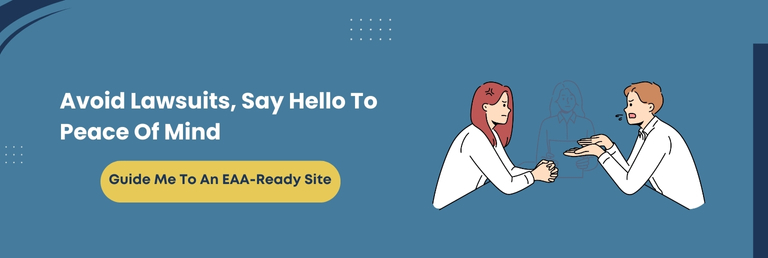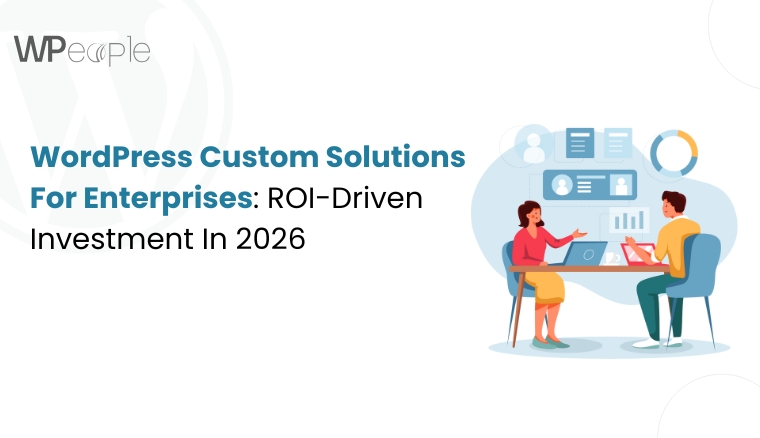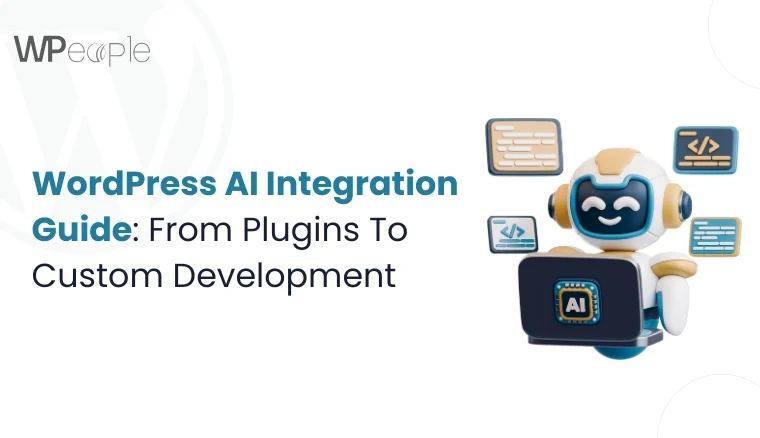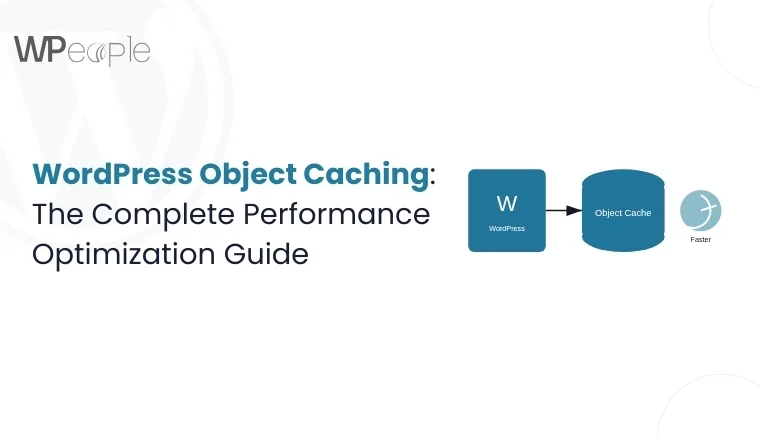
Imagine this: It’s mid-2025, and your WordPress website, though beautifully designed, quietly fails to meet a new legal standard, which is overwhelming businesses and organizations across the European Union. The result? Fines, lost visitors, and a reputation hit you didn’t see coming. Sounds like a nightmare? It is if the necessary actions aren’t implemented.
Did you know that over 100 million people in the EU live with some form of disability? Yet, many websites still ignore their fundamental right to access digital content without barriers. With the European Accessibility Act 2025 (EAA) just around the corner, this is no longer a nice-to-have feature; it’s mandatory.
So, here’s the big question: Is your WordPress website EAA-compliant, and what’s at stake if it isn’t? No need to panic as this blog has got you covered.
This guide is built for WordPress site owners, developers, digital agencies, and decision-makers. We’ll walk you through what the EAA is, why it matters, who needs to comply, and how to make your WordPress website meet accessibility standards hassle-free.
You’ll also discover practical tips, tools, and examples to help you make your website more inclusive, legally compliant, and future-ready – all in a straightforward, easy-to-understand way.
Let’s future-proof your website, not just for compliance but for everyone who visits it.
Understanding The Importance Of EAA & Accessibility
Accessibility is no longer optional, especially for digital experiences in 2025. It’s a legal, ethical, and practical necessity.
The European Accessibility Act 2025 is built on a simple but powerful principle: everyone deserves equal access to digital services. That includes websites, mobile apps, eCommerce platforms, PDFs, and everything in between.
Whether someone uses a screen reader or keyboard navigation or requires high contrast to see content clearly, your website must accommodate them.
This shift isn’t just about ticking a compliance box. It’s about creating a web experience that works for everyone without exception.
Why It Matters For WordPress Users
With over 43% of the web powered by WordPress, website owners now carry a greater responsibility to meet accessibility standards. It doesn’t matter if your site is visually stunning. If it lacks WordPress screen reader compatibility, fails basic keyboard navigation, or ignores alt text for images, it is potentially unlawful under the EAA.
That’s why understanding what the law demands and how it applies to WordPress is critical. It’s not about changing your platform. It’s about how you build and maintain your website on that platform with accessibility in mind.
What You Should Know: Accessibility isn’t just a trend. The European Accessibility Act 2025 (EAA) puts it front and center as a must-have legal obligation. WordPress users must rethink how they design and manage their sites to stay compliant, inclusive, and competitive.
What Is The European Accessibility Act (EAA)?
The European Accessibility Act 2025 is a legislative game-changer. It sets a new standard for how digital products and services must be built and accessible for everyone, regardless of ability.
The Background And Purpose
Passed in 2019, the EAA was introduced to harmonize accessibility rules across EU member states. It aims to remove digital barriers that people with disabilities face when navigating websites, apps, or using everyday digital services.
Its core goal is to make essential digital experiences accessible, inclusive, and consistent across Europe. This isn’t a suggestion. It’s an enforceable law, and businesses within and outside the EU must comply if they serve European users.
What Falls Under Its Scope?
If your service touches users in the EU, the EAA applies. It covers:
- eCommerce websites and mobile apps
- Banking services and self-service terminals
- E-books and e-readers
- Public transport ticketing and travel info platforms
- Audio-visual media services
- Online communication services
WordPress websites offering products, content, or services within the EU fall squarely under this umbrella. That’s where issues like WordPress accessibility testing, accessible forms, and even keyboard navigation start to matter a lot more.
Main Point: The European Accessibility Act 2025 is not just about compliance; it’s about giving all users equal access to digital spaces. If your WordPress website connects with European users, it must follow these new rules.
Who Must Comply With The EAA?
The European Accessibility Act 2025 is not just a call to action for government websites. It applies to a much broader group, especially businesses offering digital products or services across the European Union (EU).
EU-Based And Non-EU Businesses
If your company is based in the EU and provides digital services or products, you must follow the EAA. But here’s the twist: Non-EU businesses that operate online and serve European consumers must also adhere to it.
That means if you run a WordPress eCommerce site from outside the EU, and your audience includes European customers, your website needs to meet accessibility standards like WordPress screen reader compatibility, keyboard navigation, and alt text image support.
Note: If your website is hosted elsewhere, the user experience it offers within the EU matters.
What About Small Businesses And Exceptions?
The EAA provides some flexibility. Microenterprises, businesses with fewer than 10 employees and less than €2 million in annual turnover may be exempt from direct compliance.
But there’s a catch. If these businesses partner with larger service providers or operate in industries such as banking, telecom, or transport, they could still be indirectly affected.
Accessibility will often become a baked-in requirement in supply chain contracts and platform guidelines. Hence, it’s wiser for WordPress site owners to stay ahead.
Future-proofing your website with WordPress accessibility best practices can shield your growth and reputation.
The Bottom Line: Whether you’re in the EU or not, if your WordPress site serves EU users, you may be required to meet the EAA standards. Exemptions exist, but don’t always guarantee immunity as accessibility expectations rise across industries.
When Does The EAA Take Effect?
The European Accessibility Act 2025 isn’t a future problem; it’s a present priority. With the final compliance deadline approaching rapidly, the clock is ticking for WordPress site owners who must prepare.
Timeline And Compliance Deadline (June 2025)
The EAA was enacted in 2019, but the real impact begins in June 2025, when enforcement officially begins. After that, any new digital products or services made available in the EU must meet accessibility requirements. That includes websites, mobile apps, eBooks, online stores, ticketing systems, and more.
If you’re planning a website redesign or launching a new WordPress build, the time to incorporate accessibility is now. Retroactive updates after 28th June 2025 could be riskier, more expensive, and subject to legal scrutiny.
What Happens If You Miss It?
- Non-compliance isn’t just a technical issue; it could mean severe consequences. You might face:
- Fines and legal actions under national enforcement bodies
- Damaged brand trust from customers who find your website inaccessible
- Missed market opportunities, especially in public sector contracts or large tenders that demand digital inclusion
For WordPress site owners, using tools like a WordPress accessibility audit checklist or investing in accessibility remediation can help identify and fix issues before they become liabilities.
What This Means For You: June 2025 is a challenging deadline. WordPress sites not aligned with EAA requirements by then could face penalties, reputation damage, or lost opportunities. Starting today gives you time to fix, test, and launch confidently.

EAA vs WCAG: What’s The Real Difference?
EAA and WCAG are often mentioned in the same breath when it comes to web accessibility. However, they are both different. Though they work together, understanding how they differ (and connect) helps WordPress website owners stay smart and compliant.
Overview Of WCAG 2.1 (AA)
WCAG, or Web Content Accessibility Guidelines, is a global standard created by the W3C. Its goal is simple: make digital content usable for people of all abilities. The current benchmark, WCAG 2.1 Level AA, includes rules on color contrast, keyboard navigation, screen reader compatibility, and more elements.
If you’ve heard about WordPress accessibility best practices, they’re almost always rooted in WCAG.
How WCAG Supports EAA Compliance
Here’s where things link up. While the European Accessibility Act 2025 is a law, WCAG is not. Instead, WCAG 2.1 AA serves as the technical reference to meet the legal requirements set by the EAA.
Think of the EAA as the “why” and WCAG as the “how.”
If your WordPress website follows WCAG 2.1 AA, you’re already on the right path to EAA compliance. It includes:
- Proper WordPress alt text for images
- Full WordPress keyboard navigation
- Adequate color contrast using tools or checkers
- Use of accessible forms and error notifications
- Logical heading structure and label associations
Tools like Lighthouse or WAVE can help test whether your WordPress website abides by WCAG and supports your EAA journey by extension.
A Quick Visual Distinction Between EAA And WCAG
| Aspect | European Accessibility Act (EAA) | Web Content Accessibility Guidelines (WCAG) |
| Nature | Legislation (Law) | Technical Standard (Guidelines) |
| Issued By | European Union (EU) | W3C (World Wide Web Consortium) |
| Purpose | Enforce digital accessibility across the EU | Provide best practices for digital accessibility |
| Applicability | Mandatory for public & private sector businesses in the EU | Voluntary but widely adopted for compliance |
| Compliance Deadline | June 28, 2025 | No deadline, but referenced by laws like EAA |
| Focus | Products & services (websites, apps, hardware, etc.) | Web and digital content accessibility |
| Technical Reference | Relies on WCAG (mostly 2.1 Level AA) for implementation | Defines specific accessibility success criteria |
| How Does It Affect WordPress? | Requires WordPress sites to meet accessibility standards | Provides the checklist for making WP websites compliant |
Smart Summary: The EAA tells you what’s required. WCAG shows you how to get there. Following WCAG 2.1 AA guidelines is the most direct way to meet the EAA’s expectations for your WordPress website.
Accessibility In Practice: The POUR Principles
The European Accessibility Act 2025 isn’t just a checklist of what to fix. It’s deeply rooted in creating meaningful, barrier-free experiences for everyone.
At the heart of accessible digital design lies the four POUR principles: Perceivable, Operable, Understandable, and Robust. These principles guide how your WordPress website should behave to support users of all abilities.
Perceivable
Your website must present content in ways that users can notice and interpret. That means screen reader-friendly elements, proper image alt text, and captions on multimedia must be clearly perceivable. Features like WordPress alt text images and keyboard-friendly navigation are your first checkpoints here.
Operable
Users should be able to interact with all elements of your website without hindrances, including those who don’t use a mouse. It is where WordPress keyboard navigation and form accessibility come into play. Ensure menus, buttons, and interactive components are easy to reach and activate.
Understandable
Your content and navigation should be straightforward to grasp. Comprehensible headings, readable fonts, and consistent behavior help users predict what happens next. This principle isn’t just good for accessibility; it also makes your content more user-friendly for everyone.
Robust
Your website must work reliably across different browsers, devices, and assistive technologies. Using WordPress accessibility testing tools like WAVE or Lighthouse ensures your website holds up currently and as technology evolves.
In a Nugget: When your WordPress site is Perceivable, Operable, Understandable, and Robust, you’re not just ticking accessibility boxes; you’re building trust, improving usability, and future-proofing your business digital presence.
How The EAA Impacts WordPress Site Owners
The European Accessibility Act 2025 isn’t just a legal checkpoint. It’s a wake-up call for WordPress site owners to reshape how their digital content speaks to everyone, including users with disabilities.
From themes and plugins to editors and forms, every corner of your WordPress setup matters.
Custom Themes And Plugin Compatibility
If your website runs on a custom theme or has been heavily customized with third-party plugins, chances are high that some features may not pass accessibility checks.
Custom-built designs often miss the mark on keyboard access, semantic HTML, or screen reader support. Hence, it’s time to fine-tune your WordPress site like a pro by ensuring your themes and plugins are compatible with accessibility standards.
Gutenberg And Classic Editor Differences
The Gutenberg block editor has come a long way, offering advancements in accessibility structure. But that doesn’t mean your content is automatically compliant.
In comparison, Classic Editor gives more manual control but requires added effort to make it accessible. Please note: Irrespective of whichever editor you use, put your website’s smart switch to work – test and adapt with intention.
Forms, Mobile Views, And Multilingual Setups
Contact forms, newsletter signups, and feedback tools often become barriers when they lack crystal-clear labels or keyboard navigation. So do mobile menus that trap users or language switchers that don’t speak to screen readers.
It’s essential to fire up your website’s true power by auditing every interaction and ensuring accessibility across devices and languages.
The Crux: Your WordPress site isn’t just for those who can see, hear, or click with ease. The EAA encourages clearing out clutter and chaos, ensuring your custom builds, editors, and user interfaces offer every visitor equal access and seamless journeys.
Must-Have Accessibility Tools And Resources For WordPress
You don’t need to start from scratch or drown in code to meet the European Accessibility Act 2025 standards. WordPress offers a rich toolkit to help you run flawlessly, systematically, and swiftly with accessibility front and center.
Here are some tools that simplify the process and bring clarity to compliance.
Helpful WordPress Plugins
Some plugins work behind the scenes to patch common accessibility issues. Here are a few worth exploring:
- WP Accessibility: Adds skip links, outlines focusable elements, and improves form labeling. It is a trustworthy choice to cover basic gaps.
- One Click Accessibility: Ideal for beginners, this wordpress plugin adds user-friendly features like contrast toggles, text resizers, and keyboard navigation helpers.
- Accessibility Widget: A handy tool for adding compliance notices and user-facing accessibility features without altering code.
Think of these as your site’s cleanup crew in one plugin. They take care of things you might miss, allowing you to stay focused on content and user experience.
Top Testing Tools To Identify Issues
You need to locate bottlenecks before fixing them. These tools help scan your website for potential trouble spots:
- WAVE: A browser extension that flags accessibility problems visually and explains them.
- axe DevTools: Built for developers, this tool runs audits within the browser and provides actionable insights.
- Google Lighthouse: It runs in Chrome DevTools and offers a quick snapshot of your website’s performance and accessibility score.
Pair these tools with regular testing, and you’ll spot issues before they affect real users or compliance deadlines.
A Quick Visual Glance
| Tool/Plugin | Type | Key Features | Best For |
| WP Accessibility | Plugin | Skip links, form labels, outline fixes | General compliance basics |
| One Click Accessibility | Plugin | Text resizer, contrast toggle, keyboard navigation | Beginners, non-coders |
| Accessibility Widget | Plugin | Adds accessibility tools without code changes | Informational accessibility |
| WAVE | Testing Tool | Visual issue detection, browser extension | Quick scans and flagging issues |
| axe DevTools | Testing Tool | In-browser audit, developer-focused | Deep diagnostics |
| Google Lighthouse | Testing Tool | Performance and accessibility reports in Chrome | Overall site health check |
Knowledge Drop: Plugins and testing tools are your first responders in the accessibility journey. Use them cleverly to put your site’s smart switch to work, find what’s broken, and fix it quickly without guesswork or headaches.
How To Make Your Website EAA-Compliant
Getting your WordPress site compliant with the European Accessibility Act 2025 may seem like a daunting task, but it’s straightforward and attainable when broken down into clear, manageable steps.
Whether you’re a developer, business owner, or content creator, following a smart compliance path can help you avoid risk, welcome more users, and stay ahead of the 2025 deadline.
Step 1: Run An Accessibility Audit
Begin with a WordPress accessibility audit checklist. Use trusted tools like WAVE, Lighthouse, or Axe to identify gaps in your current design and code. These tools scan for issues, such as missing WordPress alt text images, imperfect color contrast, broken keyboard navigation, and screen reader problems.
Step 2: Fix The Most Critical Barriers
Once you have the audit report, fix the most impactful issues first:
- Work on keyboard navigation for users who don’t use a mouse.
- Add descriptive alt text to all crucial images.
- Use a WordPress color contrast checker to ensure readable text.
- Ensure your forms are WordPress-accessible with proper labels, focus states, and error messages.
Step 3: Choose Accessibility-Friendly Themes And Plugins
If your current setup causes more problems than it solves, switch to a WordPress accessibility-compliant theme and plugins that follow WordPress accessibility best practices. Avoid themes that override browser defaults or use inaccessible JavaScript components.
Check the WordPress accessibility plugins list for tested options like:
- WP Accessibility
- One Click Accessibility
- Accessibility Checker
These tools assist in rectifying code-level issues and maintaining ongoing accessibility.
Step 4: Write And Display An Accessibility Statement
An accessibility statement that WordPress users can find easily on your site is not just good practice; it’s becoming an EAA essential. It shows users what steps you’ve taken, where you stand, and how they can get in touch if they face issues.
Handy Tip: Use a WordPress accessibility statement generator or draft a custom version customized to your site’s journey.
Step 5: Add A Feedback Form
Give users a simple way to report accessibility problems. This demonstrates you care about continuous advancement and stay legally safe by showing a willingness to correct known problems.
Step 6: Keep Testing And Training
Accessibility is not a one-time fix. Schedule regular scans and engage in WordPress accessibility training to keep your team updated. Enterprise websites can consider professional WordPress accessibility compliance services or audits.
Core Thought: Making your site EAA-compliant doesn’t mean starting over. A structured approach like auditing, fixing, and future-proofing can help you build an accessible, inclusive WordPress experience that’s legally safe and user-friendly.
The Benefits Of Web Accessibility
Complying with the European Accessibility Act 2025 isn’t just about avoiding penalties; it’s about building top-notch, innovative websites that serve everyone. Focusing on accessibility elevates user experience, cultivates trust, and expands your reach to a broader audience.
Better SEO, Better Visibility
Accessibility improvements like semantic HTML, alt text, and uncomplicated navigation also boost your SEO. Search engines value well-structured content that’s easy to crawl.
Following WordPress accessibility standards makes it more straightforward for people and bots to understand and rank your website.
Improved User Experience For All
Features like keyboard navigation, comprehensible forms, and readable contrast benefit more than just users with disabilities. They make your website more effortless for everyone, including people on mobile devices, older adults, and even users with slow internet connections.
Stronger Brand Reputation
When your website welcomes all visitors, it reflects positively on your brand. It shows responsibility, inclusivity, and care for user needs. It can lead to heightened loyalty, more referrals, and increased customer satisfaction.
Reach A Larger Audience
Approximately 87 million people in the EU live with some form of disability. If your WordPress site isn’t accessible, you’re unfortunately closing the door on millions of potential visitors, customers, or clients. WordPress accessibility refinements help you tap into this overlooked market.
Higher Conversions
Simple design adjustments that follow WordPress accessibility best practices, such as readable fonts, focusable buttons, and a coherent flow of pages, can help reduce bounce rates and amplify conversions. A smoother experience leads to longer sessions, more interactions, and favorable results.
Essential Insight: Accessibility is not a limitation; it’s a necessary upgrade. Building an accessible WordPress website opens doors to peak performance and creates a space that works for everyone.
CTA Content: Make Every Visitor Feel Seen, Heard, And Clicked
CTA Button: Build A Website Everyone Can Use →
The Risk Of Not Complying With EAA
Ignoring the European Accessibility Act 2025 isn’t just a design oversight; it’s a business liability. If your WordPress site doesn’t meet the legal usability standards outlined in the EAA by June 28, 2025, the consequences could go far beyond a substandard user experience.
Legal And Financial Repercussions
Non-compliance can lead to severe penalties. Regulatory bodies across the EU are empowered to enforce the EAA through fines, warnings, and mandatory corrective actions. If your website is found to create digital barriers, you could face ongoing scrutiny or even legal proceedings.
Reputational Damage
Failing to conform to inclusivity can hamper how people view your brand. Today’s consumers expect companies to value digital equity. A website that excludes users with disabilities can quickly lose public trust and customer loyalty.
Note: People remember how your website made them feel, and exclusion isn’t forgettable.
Competitive Disadvantage
As more businesses embrace inclusive web guidelines, those lagging may find themselves left out. Government organizations, large-scale enterprises, and even B2B clients now demand that their partners and vendors meet digital inclusivity requirements.
If your website can’t deliver, it might be overlooked for significant opportunities.
Key Takeaway: Non-adherence to the European Accessibility Act 2025 could result in legal fines, lost trust, and missed partnerships. A website that’s not user-first in design will fall behind. Taking action now is an intelligent move for future-proofing your brand.
Conclusion
The European Accessibility Act 2025 isn’t just another piece of regulation; it’s a powerful push toward a web that works for everyone. For WordPress website owners, this is your moment to lead with purpose.
Throughout this guide, you’ve explored how the EAA reshapes digital responsibilities, who it applies to, what it demands, and how your WordPress site fits into the picture. We’ve walked through inclusive design principles, explored usability tools, and broken down step-by-step how to build a website that invites every visitor in, and no exceptions.
Whether you’re a solo creator, part of an agency, or managing enterprise-scale websites, adhering to the EAA isn’t just about avoiding fines or ticking off boxes. It’s about showing your users that their experience matters. It’s about creating plain sailing navigation, comprehensible content, and interfaces that feel like home to everyone.
Don’t wait for the deadline to define your direction. Start removing barriers by working on one improvement at a time.
Remember, a compliant website isn’t just a legal win. It’s a gateway to a faster, friendlier, more future-proof web experience.
We hope this blog serves as your lighting guide in making your website EAA-compliant.
FAQ
Do WordPress Theme Developers Need To Make Their Themes EAA-Compliant?
Yes. If your themes are sold or distributed within the EU and used by businesses offering services to EU consumers, they must meet EAA standards. Accessibility-ready themes with proper semantic markup, contrast ratios, and keyboard navigation are pivotal for compliance.
Can Third-Party Plugins Break EAA Compliance On My WordPress Site?
Absolutely. Plugins that generate non-accessible forms, pop-ups, or media elements can violate compliance. It’s vital to test third-party plugins for accessibility or use trusted plugins designed with inclusivity in mind.
Is Using An Accessibility Overlay Enough For EAA Compliance?
No. Accessibility overlays are often seen as a temporary fix and can miss profound structural issues. EAA compliance requires thorough development practices, testing, and actual improvements, not just surface-level mending.
How Often Should I Conduct Accessibility Audits On My WordPress Site?
Ideally, audits should be done after significant updates or design changes. Perform a comprehensive accessibility audit at least every 6–12 months to ensure ongoing compliance and to catch new issues beforehand.
What Accessibility Training Options Are Available For WordPress Teams?
Several online platforms offer WordPress-specific accessibility training, including courses from W3C, Deque, and accessibility-focused WordPress communities. Team training ensures consistent development practices and makes compliance more manageable in the long-term.
Consult with Our WordPress Experts On:
- WooCommerce Store
- Plugin Development
- Support & maintenance




